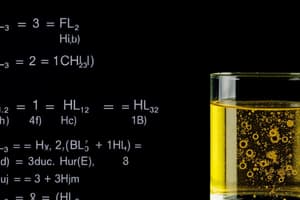Podcast
Questions and Answers
In a redox reaction, one substance is reduced (loses electrons) while another substance is oxidized (gains electrons).
In a redox reaction, one substance is reduced (loses electrons) while another substance is oxidized (gains electrons).
False (B)
Oxidation numbers are used to keep track of the atoms in a chemical equation.
Oxidation numbers are used to keep track of the atoms in a chemical equation.
False (B)
Redox reactions are chemical reactions in which the oxidation states of atoms remain the same.
Redox reactions are chemical reactions in which the oxidation states of atoms remain the same.
False (B)
Neutral atoms have an oxidation number of 1.
Neutral atoms have an oxidation number of 1.
In a redox reaction, the oxidation state of one substance increases while the oxidation state of another substance decreases.
In a redox reaction, the oxidation state of one substance increases while the oxidation state of another substance decreases.
In a redox reaction, hydrogen is always oxidized and chlorine is always reduced.
In a redox reaction, hydrogen is always oxidized and chlorine is always reduced.
The number of electrons transferred in an oxidation-reduction reaction must be equal on both sides of the equation.
The number of electrons transferred in an oxidation-reduction reaction must be equal on both sides of the equation.
Balancing redox reactions is not an important aspect of writing chemical equations.
Balancing redox reactions is not an important aspect of writing chemical equations.
In the reaction Cu + H2O → CuO + H2, copper is oxidized and water is reduced.
In the reaction Cu + H2O → CuO + H2, copper is oxidized and water is reduced.
Redox reactions do not play a crucial role in various chemical processes, such as combustion and respiration.
Redox reactions do not play a crucial role in various chemical processes, such as combustion and respiration.
Study Notes
Chemical reactions are a fundamental aspect of chemistry, as they involve the rearrangement of atoms to form new compounds. One type of chemical reaction is redox reactions, which involve the transfer of electrons between atoms. In this article, we will discuss the basics of redox reactions and how they are represented in chemical equations.
Redox reactions are chemical reactions in which the oxidation states of atoms change. Oxidation is the loss of electrons, while reduction is the gain of electrons. In a redox reaction, one substance is oxidized (loses electrons) while another substance is reduced (gains electrons). This process can be represented in an equation using oxidation numbers to keep track of the electrons.
Oxidation numbers are assigned to atoms in a chemical equation to indicate their oxidation state. The rules for assigning oxidation numbers include:
- Neutral atoms (e.g., O, Cl) have an oxidation number of 0.
- Ions have an oxidation number equal to their charge.
- Elements in their elemental form have an oxidation number of 0.
For example, in the reaction between hydrogen and chlorine to form hydrochloric acid, hydrogen is reduced (gains electrons) while chlorine is oxidized (loses electrons):
Reduction: H2 → 2H+ + 2e-
Oxidation: Cl2 + 2e- → 2Cl-
The overall redox reaction is:
Overall reaction: 2H2 + Cl2 → 2HCl
In this reaction, hydrogen is reduced (gains electrons) and chlorine is oxidized (loses electrons), resulting in the formation of hydrochloric acid.
Balancing redox reactions is an important aspect of writing chemical equations. The number of electrons transferred in an oxidation-reduction reaction must be equal on both sides of the equation. This is because the law of conservation of mass requires that the same number of electrons must be involved in the reaction on both sides.
Example problem: Balance the following redox reaction:
Cu + H2O → CuO + H2
To balance this equation, we need to determine the number of electrons transferred in the reaction. We can do this by assigning oxidation numbers to each atom:
Reduction: Cu → Cu2+ + 2e-
Oxidation: H2O → H2O2 + 2e-
Overall reaction: Cu + H2O → Cu2+ + H2O2
This equation is balanced because the same number of electrons (2) is transferred in the oxidation and reduction reactions.
Redox reactions play a crucial role in various chemical processes, such as combustion, rusting, and respiration. Understanding how to balance redox reactions is essential for writing accurate and balanced chemical equations.
Studying That Suits You
Use AI to generate personalized quizzes and flashcards to suit your learning preferences.
Description
Learn about the basics of redox reactions, including oxidation numbers, oxidation states, and balancing chemical equations. Understand how to assign oxidation numbers and balance redox reactions with examples.



